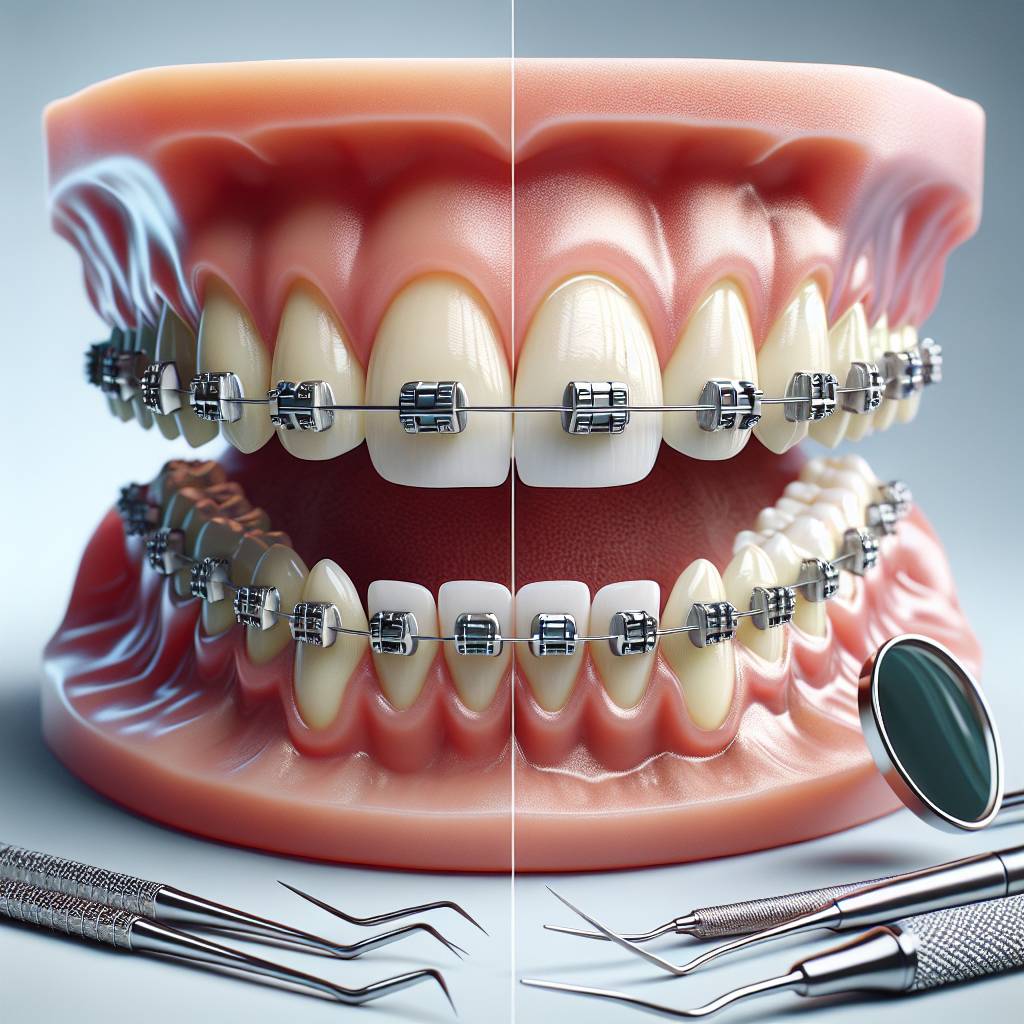Braces are an effective solution for many dental issues, including crooked or crowded teeth, misaligned jaws, and incorrect bite patterns. Braces can help realign the teeth and jaws into their proper positions, resulting in a healthier and more attractive smile. With braces, you can expect improved oral health, decreased risk of tooth decay or other dental problems, and a better overall appearance. This article will discuss how braces can help your teeth and why they may be a good option for you.Braces are a form of orthodontic treatment that uses brackets and wires to help straighten teeth and align the jaw. They are usually made of metal, but can also be made from ceramic or plastic. Braces use constant, gentle pressure to slowly move teeth into the desired position.
How Do Braces Work?
Braces are used to straighten teeth, correct misalignment, and improve the overall appearance of your smile. They work by applying pressure to the teeth and gradually shifting them into their desired position. This process is usually done over a period of several months or even years. The braces are typically composed of brackets, wires, and bands that are connected together to provide the necessary force to move the teeth.
The brackets are usually made from either metal or ceramic and they are glued onto each individual tooth. Wires then connect the brackets together and apply pressure to shift the teeth in the desired direction. The wires can be adjusted by a dentist or orthodontist at regular intervals in order to increase or decrease the amount of pressure being applied. Bands may also be used around the back molars as an extra level of stability for when more force is needed.
Once enough pressure has been applied, a retainer may be used to hold the newly aligned teeth in place while they settle into their new positions. Retainers can be removable or fixed and need to be worn for a certain period of time in order to maintain the results achieved with braces treatment.
Overall, braces work by applying constant pressure over a period of time until your teeth move into their desired position. This process requires regular visits with your orthodontist in order to make sure that everything is progressing properly and that you’re on track for achieving your desired results.
What Are the Benefits of Braces?
Braces are a great way to improve the appearance of your smile, but many people are unaware of the other health benefits they can bring. Braces can help to correct misaligned teeth and jaws, providing a range of long-term benefits. Not only do braces improve the aesthetics of your smile, they also help to prevent problems such as tooth decay, gum disease, and uneven wear on teeth.
One of the most significant benefits of braces is improved oral hygiene. By correcting misaligned teeth and jaws, braces make it easier to maintain good oral hygiene practices. This can significantly reduce the risk of tooth decay and gum disease, which are both serious health risks that can lead to long-term complications.
Another benefit of wearing braces is improved speech. When teeth are misaligned or out of position it can affect the way you speak or pronounce words. By correcting these issues with braces you can significantly improve speech clarity. In addition, braces are also believed to help with other problems such as snoring and sleep apnea.
Finally, wearing braces can also improve chewing efficiency by helping to reposition crooked or crowded teeth into their correct positions. This makes it easier to chew food properly which can lead to better digestion and overall health benefits.
In conclusion, there are many benefits associated with wearing braces beyond just improving the aesthetics of your smile. Braces can help with oral hygiene by making it easier to brush and floss correctly, as well as improving speech clarity and chewing efficiency which may lead to improved digestion and overall health benefits in the long run.
How Long Does it Take to Get Results with Braces?
The amount of time it takes to get results from wearing braces will vary depending on the type of brace and the severity of the orthodontic issue. Generally, braces can take anywhere from 6 months to 2 years to achieve the desired results. For minor orthodontic issues, the process may be quicker than for more complicated cases.
Invisalign is a popular option for those who want an invisible and removable solution. This option typically takes an average of 12 months to complete, and the amount of time can vary depending on how often you wear your aligners and how compliant you are with your treatment plan. Traditional metal braces usually take about 18-30 months to complete. Ceramic braces can take longer than metal braces due to their slow adjustment process, but they tend to be less noticeable than metal braces.
No matter what type of brace you choose, it is important that you follow your orthodontist’s instructions in order to get the best possible result in a timely manner. This includes regular visits for monitoring and adjustments as well as following directions for proper cleaning and care of your braces. If you are diligent with your treatment plan, you can expect results in 6 months to 2 years depending on the type of brace and severity of your case.
Types of Braces
Braces are dental appliances used to correct misalignment of teeth and jaws. There are several different types of braces available, each with its own unique advantages. Traditional metal braces are the most common type, and they use metal brackets and wires to move teeth into their proper positions. Ceramic braces are similar to traditional metal braces, but they use tooth-colored brackets that blend in with the teeth for a less noticeable appearance. Lingual braces are hidden behind the teeth, making them almost invisible from the front view. Invisalign is a newer type of brace that uses removable clear aligners to move the teeth into position without the use of metal brackets or wires. Finally, self-ligating braces use specialized clips instead of elastics to hold the archwire in place, making them easier to clean and maintain.

How Much Do Braces Cost?
The cost of braces varies depending on the type of braces and the treatment plan that is required. Generally, traditional metal braces cost between $3,000 and $7,000, while ceramic braces typically cost between $4,000 and $8,000. Lingual braces, which are placed behind the teeth, can range from $8,000 to $10,000 for a full set. Invisalign aligners range from $5,000 to $7,500 for a full set.
The exact cost of braces will depend on the individual’s dental needs and the severity of their misalignment. Other factors such as additional treatments or orthodontic appliances can also affect the cost. For example, a person may need to have their teeth whitened or adjusted before they can begin wearing braces. It is important to speak with an orthodontist about their specific treatment plan in order to get an accurate estimate of how much it will cost.
It is also important to note that many insurance plans provide coverage for orthodontic treatments. A person should check with their insurance provider to see if they are eligible for any discounts or coverage on orthodontic treatments before making an appointment with an orthodontist.
What Are the Risks of Getting Braces?
Getting braces can be a great way to improve your smile, but there are some risks associated with them. The most common risks involve discomfort, irritation, and even injury. While it is rare for these issues to arise, it is important to know what to look out for and how to manage them.
The most common risk associated with braces is discomfort. Braces can cause pain and soreness in the teeth and gums as they are adjusted. This is usually temporary, but it can last for several days or even weeks. Some people may also experience irritation from the metal brackets or wires rubbing against their cheeks or gums. To help ease any discomfort, it is important to practice good oral hygiene and use orthodontic wax if needed.
Injury is another potential risk of getting braces. It is possible for the metal brackets or wires to cut into the soft tissues of the mouth if they become too tight or are not adjusted properly. If this happens, it can lead to infection or even damage to the teeth and gums if not treated right away. It is important to talk with your orthodontist about any concerns you have about your braces so that they can adjust them as needed.
Finally, there are also aesthetic risks associated with getting braces. If you have poorly fitted braces or do not follow instructions from your orthodontist carefully, you could end up with crooked teeth when they come off. In addition, some people may find that their teeth look yellow after having their braces removed due to staining from foods and drinks during treatment. To reduce this risk, make sure you brush regularly while wearing braces and use special whitening toothpaste afterwards if needed.
Overall, getting braces can be a great way to improve your smile but there are some risks involved that should be taken into consideration before making a decision. Be sure to discuss any concerns you have with your orthodontist so that they can help you make an informed decision about whether or not braces are right for you.
Is It Painful to Get Braces?
Getting braces is not typically considered a painful process. However, some people may experience some discomfort or sensitivity during the fitting or adjustment of the braces. After the braces are put on, it is normal to feel soreness in the mouth and around the teeth for a few days. You can take over-the-counter pain relievers, such as ibuprofen or acetaminophen, to ease any discomfort.
The orthodontist may also give you wax to cover any areas of the braces that are causing irritation. You can place this wax over any sharp points on your braces to prevent them from cutting your mouth or lips. The orthodontist may also use special tools and techniques during your appointment to make sure that the braces don’t pinch your cheeks and gums.
Overall, getting braces should be a relatively painless experience. If you have questions or concerns about any discomfort you are feeling during your appointment, make sure to tell your orthodontist so they can address it right away.

Conclusion
Braces are an effective tool for helping to maintain the health of your teeth. They can help correct misalignment, improve the overall look of your smile, and help protect your teeth from damage caused by crooked or crowded teeth. In addition, they can also help improve dental hygiene by making it easier to reach all the areas of your mouth that need to be cleaned.
Overall, braces are a great way to take care of your oral health and maintain a beautiful smile. With regular visits to your orthodontist and proper oral hygiene, you can ensure that your braces will work properly and that you’ll have healthy teeth for years to come.
If you’re considering braces for yourself or a loved one, be sure to speak with an orthodontist in order to understand the process and expected results. With the right treatment plan, braces can make a huge difference in the health and appearance of your smile!

